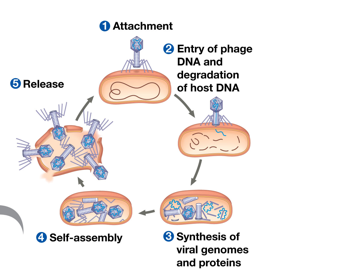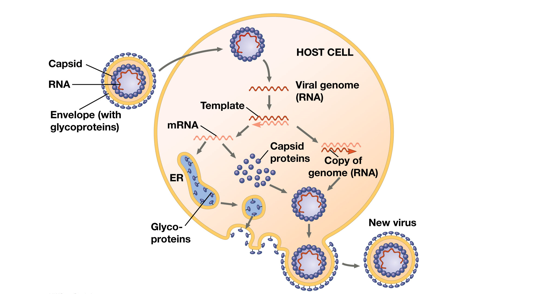Viruses
1/65
There's no tags or description
Looks like no tags are added yet.
Name | Mastery | Learn | Test | Matching | Spaced |
|---|
No study sessions yet.
66 Terms
Virus
Infectious particle consisting of little more than one or more molecules of nucleic acid enclosed in a protein coat
Viral genomes can consist of
double/single-stranded DNA
double/single-stranded RNA
Capsid
protein shell enclosing the viral genome
What are capsids made out of?
protein subunits called capsomeres
Viral envelopes
membranous envelopes that help viruses infect hosts.
contain both viral and host molecules
Bacteriophage
viruses that infect bacteria
Obligate Intracellular Parasite
The virus must live and reproduce inside a host cell—it can’t replicate or do anything on its own.
Host range
A limited number of host species that it can infect
When does viral infection begin?
When a virus binds to a host cell, and the viral genome enters the cell
Generally, what does a virus do after entry in a host?
replicate inside of the host using the host’s own organelles. they then burst out of the cell
What are the replicative cycles of phages?
lytic cycle
lysogenic cycle
Lytic cycle
phage replicative cycle, results in death of the host cell.
Virulent phage
A phage that can reproduce only through the lytic cycle

What cycle is this?
The Lytic cycle
Lysogenic cycle
replicates the phage genome without destroying the host
Temperate phage
A phage that uses both the lytic and lysogenic cycle
What happens in the lysogenic cycle?
Viral DNA integrates with the host’s DNA and replicates within the host cell. Can remain dormant for a long time until triggered to enter the lytic cycle
Prophage
Viral DNA that is integrated into a bacterial cell’s genome
Restriction enzymes
cuts specific DNA sequences; protects the bacteria from viral DNA
How does bacteria prevent itself from cutting up its own DNA?
The bacteria methylates its DNA at the recognition sites
What is the CRISPR-Cas system and how does it protect bacteria?
Stores viral DNA sequences and uses RNA-guided Cas proteins to recognize + cut matching viral DNA in the future. Kind of like a bacterial immune system
What are the two key variables used to classify viruses that infect animals
DNA or RNA
Presence or Absence of an envelope
How can viruses use their envelopes to enter host cells?
Glycoproteins from the envelope bind to specific receptor molecules on the host cells surface
Budding
Enveloped viruses exit the host cell by pushing through the membrane, taking a piece of it as their envelope, often without killing the cell.

What is this
The Replicative Cycle of an Enveloped RNA Virus
Where is the broadest variety of RNA viruses found?
Viruses that can infect animals
What are positive-sense RNA viruses?
capable of operating as mRNA and can be directly translated into the protein in the host
Retrovirus
Use reverse transcriptase to copy their RNA genome into DNA
What retrovirus causes AIDS?
HIV
Provirus
Viral DNA that is integrated into the host genome
What is the difference between a provirus and a prophage?
prophage is for bacterial cells, provirus is for eukaryotic cells
How do retroviruses replicate?
virus enters host cell
reverse transcriptase makes DNA from RNA
Viral DNA integrates into host DNA
host cell transcribes viral genes
new viruses are assembled and released
Do retroviruses go through the lytic cycle?
No. The only thing that leaves the host cell is a new virus that buds from the host cell.
When did viruses likely evolve?
After cells appeared, since they need hosts to replicate.
What are possible sources of viral genomes?
Plasmids (circular DNA) and transposons (mobile DNA segments)—both can move between cells.
How do viruses damage or kill animal cells?
By triggering the release of hydrolytic enzymes from lysosomes.
How do viruses cause disease symptoms?
They may cause cells to make toxins or contain toxic components like envelope proteins.
What causes many viral infection symptoms?
The body’s own immune response, not the virus directly.
Vaccine
Harmless derivative of a pathogen
Stimulates the immune system to mount defenses against the harmful pathogen
What do antibiotics target?
Enzymes specific to bacteria; they are powerless against viruses
What do antiviral drugs do?
They help treat—but do not cure—viral infections
Why are receptor proteins important in viral infections?
They’re targets for treatment or prevention; viruses use them to enter cells.
What does the SARS-CoV-2 vaccine target?
The virus’s spike protein, which binds to host receptors.
What receptor does HIV mainly use to enter cells?
CD4 protein.
How is CCR5 used in HIV treatment?
Drugs can block or mask CCR5 to prevent HIV from binding and entering cells.
Emerging viruses
Viruses that suddenly become apparent
Can be common in a local population, but spread rapidly when introduced outside of that population
Epidemic
general outbreak within a community. could be a new disease or an existing one, but if there is a large increase in a general population
Pandemic
Global outbreak of disease → global epidemic
How did the chikungunya virus spread?
Through mosquitoes
What contributes to the emergence of viral diseases
Mutation of an existing virus
Spread from a small, isolated population
Spread from animal populations
The less similar an animal is to a human, the ______ deadly the disease is to humans
more
Which influenza strain has caused 4 major pandemics in the last 100 years (as of may 2025)
Influenza A
Which influenza strain(s) only infect humans?
B and C
Netting
Form of vector control in public health
Put a barrier between humans and virus-carrying mosquitoes
Prion
Infectious, misfolded protein
What can cause degenerative brain diseases in many animal species
Prions
Prions act very ______
slowly. incubation period of at least 10 years
Are prions destructable
fuck no. they resist heat and radiation and enzymes and stuff
Prion transmission
food, contamination, sometimes genetics
whats the cure for prion diseases?
youre fucked actually there is none
What happens after you denature a prion?
it refolds…
Creutzfeldt-Jakob Disease (CJD)
most common prion disease; causes rapid neurodegeneration
Fatal Familial Insomnia
inherited prion disease; causes progressive insomnia, then death
Kuru
prion disease espread by ritual cannibalism in Papua New Guinea
Bovine Spongiform Encephalopathy (BSE)
“mad cow disease” - caused by prions
How do prions infect other proteins?
By binding to normal proteins and causing them to misfold, triggering a chain reaction that leads to protein clumps and brain damage.